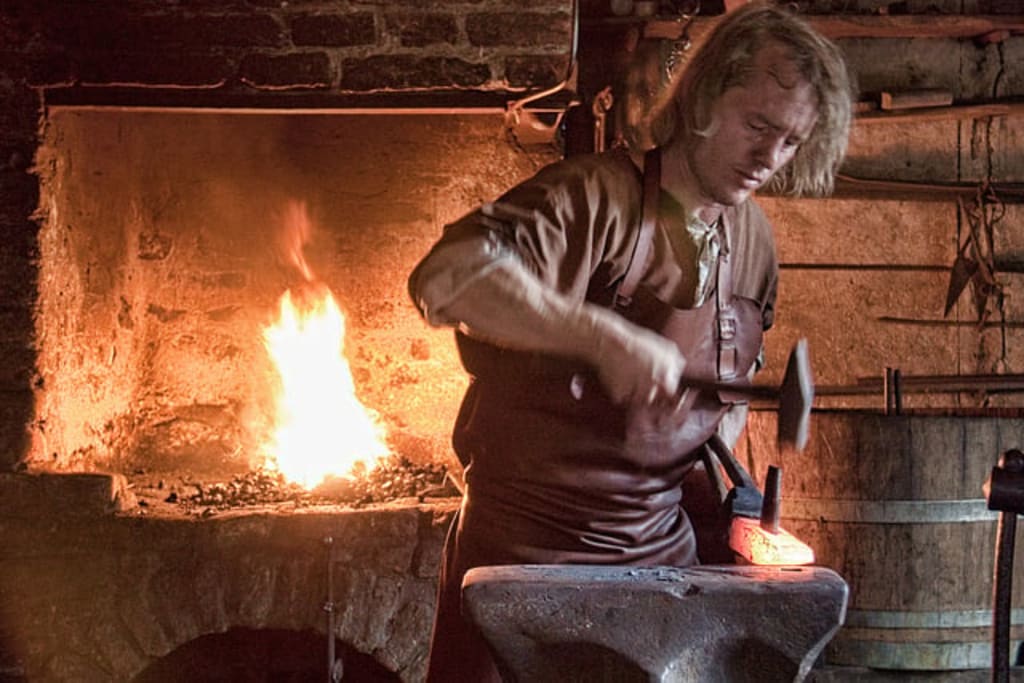IF I WAS BORN IN THE MIDDLE AGES
The Life of a Blacksmith in the Middle Ages: Mastering the Forge

Introduction:
In the bustling towns and villages of the Middle Ages, amidst the clanging of hammers and the fiery glow of the forge, the blacksmith held a vital and respected position. Serving as the backbone of medieval society, the blacksmith's occupation was instrumental in shaping the world of that time. If I were born in the Middle Ages, I would proudly assume the role of a blacksmith, dedicating my life to the art of metallurgy, crafting essential tools and weapons, and contributing to the growth and prosperity of my community.
The Blacksmith's Workshop:
The heart of a medieval blacksmith's trade was their workshop. Typically located near the town square, the workshop would be equipped with a sturdy anvil, bellows to fan the flames, and a variety of hammers, tongs, and other specialized tools. The workshop would also have storage areas for different types of metals, such as iron and steel, as well as coal or charcoal to fuel the forge.
Crafting Essential Tools:
One of the primary responsibilities of a blacksmith in the Middle Ages was crafting essential tools that were crucial for everyday life. Farming implements, such as plows, sickles, and hoes, were in high demand as agriculture formed the backbone of the medieval economy. The blacksmith would carefully shape and temper the metal, transforming raw materials into robust tools capable of withstanding the rigors of laborious tasks.
Weapons and Armor:
Another significant aspect of a medieval blacksmith's occupation was the production of weapons and armor. In an era characterized by constant warfare, knights, soldiers, and mercenaries relied on the skill of blacksmiths to supply them with high-quality arms. Swords, axes, spears, and shields were forged with great care, ensuring they were not only effective in combat but also durable and well-balanced.
Armor was equally crucial, providing protection to those on the battlefield. The blacksmith would fashion suits of plate armor, chainmail, and helmets, employing their knowledge of metalworking techniques to create pieces that would shield warriors from harm. The artistry and craftsmanship of the blacksmith played a pivotal role in determining the quality and effectiveness of these essential defensive and offensive tools.
Repair and Maintenance:
Beyond crafting new tools and weapons, the blacksmith was also responsible for repairs and maintenance. In the Middle Ages, where resources were scarce and recycling was a necessity, the ability to restore damaged items was invaluable. Blacksmiths would restore worn-out tools, mend broken weaponry, and even mend damaged armor. Their expertise allowed them to breathe new life into otherwise discarded or unusable items, reducing waste and saving valuable resources.
Social Importance and Integration:
The blacksmith was not just a skilled artisan; they held a prominent social position within medieval society. As a blacksmith, I would interact with a wide range of people, from farmers and merchants to nobles and knights. I would forge relationships with other craftsmen, creating a network of skilled professionals that would contribute to the growth and prosperity of our community.
Furthermore, the blacksmith's workshop often served as a gathering place for townsfolk. People would come to observe the smith's work, discuss local matters, and exchange news. The blacksmith was a respected figure, admired for their strength, skill, and knowledge. Their position in society granted them a unique voice and influence, enabling them to participate in decision-making processes and contribute to the betterment of their community.
Conclusion:
If I were born in the Middle Ages, becoming a blacksmith would be a fulfilling and meaningful occupation. The artistry, skill, and dedication required to master the craft of metalworking would allow me to contribute to the growth and prosperity of my community. Through the creation of essential tools, weapons, and armor, as well as the repair and maintenance of existing items, I would play a vital role in shaping the world around me. As a blacksmith, I would not only provide for myself but also be an integral part of the social fabric, respected and admired for my contributions to the well-being and strength of medieval society.
About the Creator
Enjoyed the story? Support the Creator.
Subscribe for free to receive all their stories in your feed. You could also pledge your support or give them a one-off tip, letting them know you appreciate their work.





Comments
There are no comments for this story
Be the first to respond and start the conversation.